#drm video encryption
Explore tagged Tumblr posts
Text
DRM Video Encryption Software or DRM Player to protect your video content
128-bit DRM Video Encryption software with DRM Player which protects your videos & content from unauthorized access. Start your free trail now - iShieldProtect®. Start your free trail now 916400 6065
#DRM Video Encryption Software#DRM player#drm video protection software#drm player#drm protection software#drm video encryption#drm software for video#drmprotected video testing#drm protected video testing
0 notes
Text
What is the importance of implementing DRM technology to secure your video content?
DRM-protected video content is critical for reducing prohibited access, piracy, and distribution while also safeguarding intellectual rights and revenue streams.
0 notes
Text
Why Your Business Needs a Cloud Video Platform Today
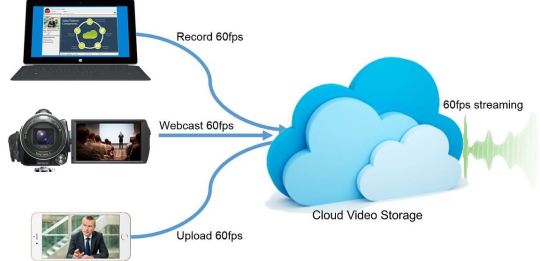
In the digital era, businesses are constantly looking for ways to enhance efficiency, reduce costs, and improve communication and collaboration. One of the technological advances that has been pivotal in achieving these objectives is the cloud video platform. This platform has revolutionized how businesses operate, offering a multitude of benefits ranging from improved communication strategies to expansive data analytics. Additionally, the cloud video platform provides scalable solutions that adapt to the needs of growing businesses, ensuring that they can maintain seamless operations. By facilitating remote work and virtual meetings, these platforms also contribute to better team collaboration and more efficient project management.
Key Benefits of Using Cloud Video Platform
A cloud video platform offers significant advantages to businesses, paramount among them being scalability, accessibility, enhanced collaboration, cost-effectiveness, and security. Understanding these benefits in detail can help organizations make informed decisions about adopting this technology, leading to more efficient operations, improved communication, and ultimately, a competitive edge in the market. Embracing cloud video solutions is a strategic move.
Scalability and Flexibility
One of the primary advantages of cloud video platform is their scalability. Businesses can effortlessly scale their video management needs up or down based on current demand without the need for significant upfront investments in hardware. This flexibility is crucial in adapting to business growth or changes without incurring additional costs or delays. Moreover, it allows companies to efficiently manage resources and respond promptly to evolving market conditions.
Accessibility and Reach
With a cloud video platform, videos can be accessed from anywhere, at any time, on any device with internet access. This global accessibility ensures that employees in different locations can easily participate in training sessions, meetings, and collaborations without the need for physical travel, further enhancing productivity across the organization. Additionally, it allows for seamless integration of remote and on-site teams, fostering a more connected and efficient workplace.
Enhanced Collaboration
A cloud video platform facilitates enhanced collaboration among teams by providing features such as real-time sharing, editing, and communication tools. These integrated features enable teams to work together more effectively, even when members are spread across various geographic locations. This real-time interaction significantly aids in quicker decision-making and problem-solving, ensuring that projects progress smoothly and efficiently regardless of physical distances.
Cost-Effectiveness
Moving to a cloud video platform can significantly reduce costs related to video content management. By leveraging cloud services, businesses eliminate the need for expensive on-premise infrastructure. Additionally, the maintenance and upgrading of systems are handled by the service provider, which can further decrease IT expenses. Furthermore, cloud platforms offer scalable solutions that allow businesses to pay only for the resources they use, optimizing budget allocation.
Security and Compliance
Security is a top concern for any business leveraging digital tools. The cloud video platform is equipped with robust security measures, including data encryption, secure access controls, and compliance with international standards. These features ensure that sensitive content remains protected against unauthorized access and breaches. Additionally, regular security audits and updates further enhance the platform's ability to safeguard valuable data, providing businesses with peace of mind and confidence in their digital security.
Improved Content Management and Analytics
A cloud video platform also offers advanced content management systems, allowing businesses to efficiently organize, manage, and retrieve video content with ease. Additionally, these platforms provide insightful analytics on viewer engagement, content performance, and other key metrics. This data-driven approach enables businesses to make informed decisions to optimize their video strategies, enhance viewer experience, and ultimately drive better results in their video marketing efforts.
Implementing Cloud Video Platform: Considerations and Best Practices
Implementing a cloud video platform yields significant benefits, but its success hinges on strategic planning and factor consideration. Vital elements encompass selecting an appropriate platform, meeting bandwidth needs, prioritizing user adoption tactics, and upholding data governance policies. These measures collectively shape a robust foundation for seamless integration and optimized performance.
Choosing the Right Platform
Selecting the appropriate cloud video platform is critical and should be based on specific business needs such as feature requirements, scalability, security, and compatibility with existing systems. Businesses should conduct thorough research or consult with experts to find the best fit.
Ensuring Adequate Bandwidth
Effective video streaming requires sufficient bandwidth. Before implementation, businesses need to assess their internet bandwidth to ensure smooth video playback and uploading capabilities without disrupting other business operations.
Focusing on User Adoption
To maximize the benefits of cloud video platform, promoting user adoption through training and support is essential. Employees need to understand how to use the platform efficiently and be comfortable with its features to fully leverage its capabilities.
Adhering to Data Governance
Businesses must also consider data governance when implementing cloud video platform. Ensuring that the platform complies with relevant laws and regulations regarding data privacy and protection is crucial.
Conclusion
The adoption of a cloud video platform can bring transformative benefits to businesses, fostering better communication and collaboration, providing scalability and flexibility, enhancing content management and analytics, reducing costs, and bolstering security. By leveraging cloud technology, organizations can streamline their operations and improve efficiency. Moreover, these platforms enable seamless remote work, support real-time collaboration, and offer advanced tools for data-driven decision-making. With careful planning and consideration of the key factors outlined above, organizations can effectively implement and use these platforms to achieve substantial business success, ensuring they stay competitive in an increasingly digital and connected world. please don’t hesitate to contact us via email or phone for further assistance!
#cloud video platform#secure video hosting#streaming video hosting#encrypted video hosting#drm encrypted video streaming#encrypted video streaming#DRM software#video hosting#security video#video platforms#online video platform#video watermark#DRM protected content#video cdn#wide vine#online courses#e-learning platforms#influencers#paid online courses#E-Learning Solutions#Digital content
0 notes
Text
PSA: Free Software
Reading this may really save your time, privacy, and money! Reblog or share to spread awareness!
Folks often use software that’s expensive and sometimes even inferior because they don’t know there are alternatives. So to those unfamiliar: basically, free and open-source (FOSS) or "libre" software is free to use and anyone can access the original code to make their own version or work on fixing problems.
That does not mean anyone can randomly add a virus and give it to everyone—any respectable libre project has checks in place to make sure changes to the official version are good! Libre software is typically developed by communities who really care about the quality of the software as a goal in itself.
There are libre alternatives to many well-known programs that do everything an average user needs (find out more under the cut!) for free with no DRM, license keys, or subscriptions.
Using libre software when possible is an easy way to fight against and free yourself from corporate greed while actually being more convenient in many cases! If you need an app to do something, perhaps try searching online for things like:
foss [whatever it is]
libre [whatever it is]
open source [whatever it is]
Feel free to recommend more libre software in the tags, replies, comments, or whatever you freaks like to do!
Some Libre Software I Personally Enjoy…
LibreOffice
LibreOffice is an office suite, much like Microsoft Office. It includes equivalents for apps like Word, Excel, and Powerpoint, which can view and edit files created for those apps.
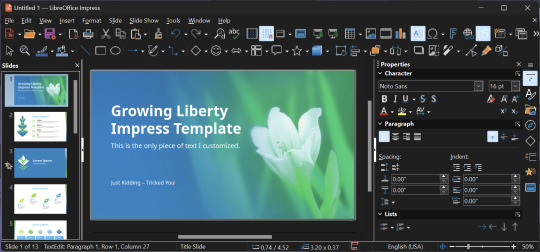
I can't say I've used it much myself yet. I do not personally like using office software except when I have to for school.
OpenShot
OpenShot Video Editor is, as the name suggests, a video editing program. It has industry-standard features like splicing, layering, transitions, and greenscreen.
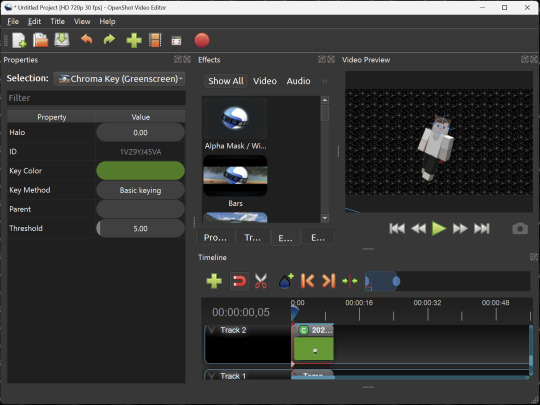
I've only made one video with it so far, but I'm already very happy with it. I had already paid for a video editor (Cyberlink PowerDirector Pro), but I needed to reinstall it and I didn't remember how. Out of desperation, I searched up "FOSS video editor" and I'm so glad I did. There's no launcher, there's no promotion of other apps and asset packs—it's just a video editor with a normal installer.
GIMP
GNU Image Manipulation Program is an image editor, much like Photoshop. Originally created for Linux but also available for Windows and MacOS, it provides plenty of functionality for editing images. It is a bit unintuitive to learn at first, though.

I've used it to create and modify images for years, including logos, really bad traceover art, and Minecraft textures. It doesn't have certain advanced tech like AI paint-in, but it has served my purposes well and it might just work for yours!
(Be sure to go to Windows > Dockable Dialogs > Colors. I have no idea why that's not enabled by default.)
Audacity
Audacity is an audio editing program. It can record, load, splice, and layer audio files and apply effects to them.

Audacity is another program I've used for a long time. It is not designed to compose music, but it is great for podcasts, simple edits, and loading legacy MS Paint to hear cool noises.
7-Zip
7-Zip is a file manager and archive tool. It supports many archive types including ZIP, RAR, TAR, and its own format, 7Z. It can view and modify the contents of archives, encrypt and decrypt archives, and all that good stuff.

Personally, I use 7-Zip to look inside JAR files for Minecraft reasons. I must admit that its UI is ugly.
Firefox
Firefox is an internet browser, much like Google Chrome, Microsoft Edge, or Safari. While browsers are free, many of them include tracking or other anti-consumer practices. For example, Google plans to release an update to Chromium (the base that most browsers are built from these days) that makes ad blockers less effective by removing the APIs they currently rely on.
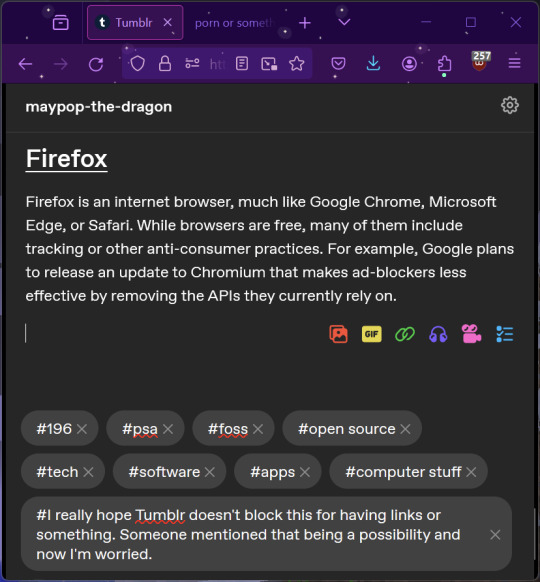
Aside from fighting monopolies, benefits include: support for animated themes (the one in the picture is Purple Night Theme), good ad blockers forever, an (albeit hidden) compact UI option (available on about:config), and a cute fox icon.
uBlock Origin
As far as I know, uBlock Origin is one of the best ad blockers there is.
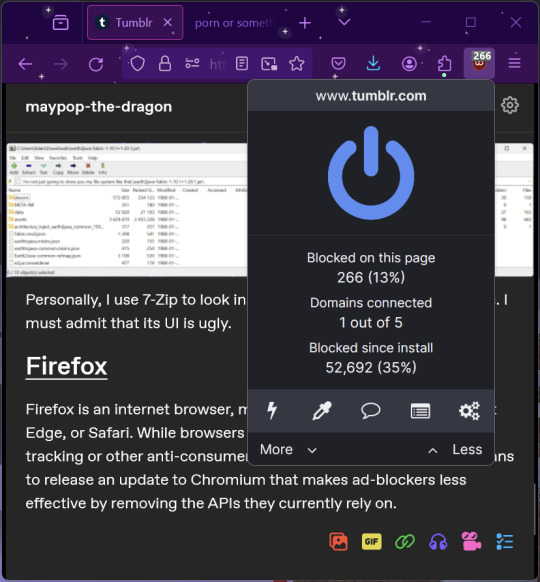
I was on a sketchy website with my brother, and he was using Opera GX's ad blocker. Much of the time when he clicked on anything, it would take us to a random sponsored page. I suggested that he try uBlock Origin, and with uBlock Origin, that didn't happen anymore.
Linux
Linux is a kernel, but the term is often used to refer to operating systems (much like Windows or MacOS) built on it. There are many different Linux-based operating systems (or "distros") to choose from, but apps made for Linux usually work on most popular distros. You can also use many normally Windows-only apps on Linux through compatibility layers like WINE.
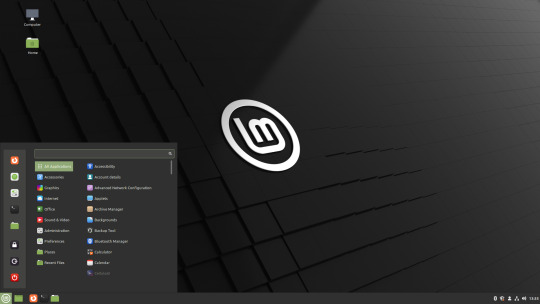


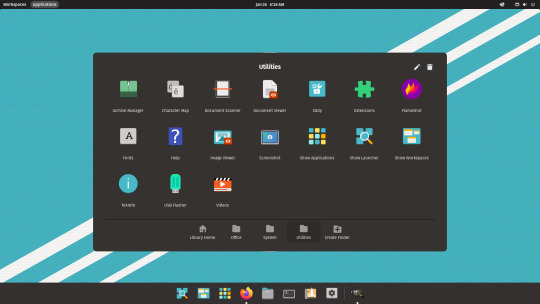
I don't have all four of these, so the images are from Wikipedia. I tried to show a variety of Linux distros made for different kinds of users.
If you want to replace your operating system, I recommend being very careful because you can end up breaking things. Many computer manufacturers don't care about supporting Linux, meaning that things may not work (Nvidia graphic cards notoriously have issues on Linux, for example).
Personally, I tried installing Pop!_OS on a laptop, and the sound output mysteriously doesn't work. I may try switching to Arch Linux, since it is extremely customizable and I might be able to experiment until I find a configuration where the audio works.
Many Linux distros offer "Live USB" functionality, which works as both a demo and an installer. You should thoroughly test your distro on a Live USB session before you actually install it to be absolutely sure that everything works. Even if it seems fine, you should probably look into dual-booting with your existing operating system, just in case you need it for some reason.
Happy computering!
#196#psa#foss#open source#tech#software#apps#computer stuff#I really hope Tumblr doesn't block this for having links or something. Someone mentioned that being a possibility and now I'm worried.#please reblog#2024-01-26
44 notes
·
View notes
Note
if you don’t want to get into detail about this i completely understand but i was wondering how you’ve been downloading videos, specifically ones like the v**ps one because i was doing everything i could to try to rip it and i couldn’t
so ngl that day was an extremely protracted process for me and it involved a lot of, like SO MUCH, googling but i will try and write what i remember - HUGE DISCLAIMER i’m seriously really really really really IT deficient and i honestly just managed to fumble my way into succeeding this one time only, i understood about 2% of what i was doing. the power of fall out boy forever and being down woeful for patrick
ok so *huddles in closer together*
btw i don't have access to the msg video anymore since i only had a week lol so any examples here are from the boz one !!!
at first i tried to just use my usual browser extension (video downloadhelper) to try and rip the stream however it's drm protected so it just gave me a huge file that only had like glitchy static and no audio, which means it's encrypted, and you need a decryption key
you need a cdm (content decryption module) to get a decryption key. i actually got really far with this and managed to get one using a virtual android phone before realising i didn't have to DO ALL THAT and can just use cdrm-project.com for this. i don't wanna dwell on it
so on the cdrm-project page, for this task you only need the PSSH and the license url.
step 1: turn off your adblock first lol i learned this the hard way. also yes you may sing this to the tune of run dry
step 2: to get the PSSH - go to the video page and play a little bit of it -> right click -> inspect -> in the "filter urls" search type "m3u8" -> look for the one that's like "widevine_cmaf_avc.m3u8" since i believe this will be the master file -> right click it -> copy value -> copy url

open command prompt -> type "curl" then paste the url, press enter -> the string of stuff beginning with AAAA is the PSSH, copy it

step 3: to get the license url - filter urls for "wide" -> this was the correct one

right click this -> copy value -> copy url
step 4: paste the PSSH and the license url into the appropriate boxes on cdrm-project and it will give you the decryption key KEEP IT AROUND
step 5: i downloaded n_m3u8DL-RE and mp4decrypt (bento4) -> unzip both -> place mp4decrypt in the same folder as n_m3u8DL-RE
step 6: open command prompt -> first place yourself in the right directory as where n_m3u8DL-RE folder is (copy address in file explorer -> type "cd" in command prompt -> paste address, press enter)
step 7: now use this command in command prompt: N_m3u8DL-RE -M format=mp4 --key [use the key gotten from the cdrm-project page] [use the master .m3u8 url]

it will show you a bunch of options for selecting the resolution you want, press enter and it'll start working

step 8: it'll take a minute so wait until it says DONE -> find the completed video file in the same folder as n_m3u8DL-RE !!
i will tell you something hilarious i discovered: i think the key works for all the videos currently up on the site. its why the boz one was a fucking breeze to get after all that for the msg one LMAOOOO and i even downloaded a couple random other things
for other videos like dvd rips i do those using handbrake which is easy and painless frolicking in a field in comparison💀
#thank u for censoring beeps i saw they alrdy took down a tube upload and *patrick voice* i am very scared rn LOL#PLEASE PLS EVERYONE GO DOWNLOAD MY FILE PLEASE ALL I WANT IS FOR AS MANY PPL AS POSSBLE TO HAVE THE FULL RESOLUTION FILE#q&a
8 notes
·
View notes
Note
how are you downloading Ici tout commence?
From the official site!
First, I use a VPN to get a French IP (or Belgian--I'm not sure which they accept, I just know these two work) so I can access the network's streaming site, TF1+. You should be able to sign up for a free account without issue. This is the page for the season 4 eps:
https://www.tf1.fr/tf1/ici-tout-commence/videos/saison-4
Apparently there are always two eps in advance available for the premium subscribers but I'm not caught up plus I think it'd be a little harder to sign up for an actual paid account so I probably won't be able to do that.
So normally I would use youtube-dl/yt-dlp to download the eps but that won't work here, or at least not without some extra steps, because these are DRMed. This is where it gets a little tricky and the whole process isn't super well documented both because it changes a lot and it makes more sense to teach people to learn how to do it than how to do it and also because, well, the more these methods are spread, the more networks change things up and make things harder.
This thread can help you get started: https://forum.videohelp.com/threads/412113-MYTF1-Help-needed-New-DRM-system-can-t-download
The whole forum is quite useful and I've only had to post for help a couple of times, mostly I just search my issue and read through.
That provided command in the second post, that's something to be used in your command line, on Windows in Start you can open that by typing in cmd or PowerShell or just google what you'll need for your computer.
These are the things you'll need to get to run the command:
N_m3u8DL-RE is a tool you can google and download, and also ffmpeg and mp4decrypt. You'll want them in the same folder for convenience. (I think you might need to install python too? If it says you do, then go ahead, lol.)
The way to get the key, this is the most gatekept part, probably. The various streamers out there use different methods of encryption and increasing security levels, and if you read up on it, you'll see stuff about kid and pssh and cdm and L3, it can be overwhelming, but in this case, the things you need are relatively easily accessible.
I'll tell you how to get the pssh and the license URL and you'll be able to use those to get the key. There are several tools you can use them on, one is public and easy, one is private but still easy-ish, and one is pretty complex and not a route I've gone down myself yet (it's the pinned thread in that particular forum). I don't want to link any of them myself, but I'll link to a thread that mentions the easy public one. It does go down at times which is why the hardcore people recommend that last method.
First, before you click on an ep, open up your browser's Developer Tools, usually Ctrl+Shift+i will do the trick. Go over to your Network tab, this shows all the requests your browser makes when you go to a site.
Then click on the episode in the actual browser. You'll see a flood of requests in the Network tab, filter on mpd.
Select the mpd result and the details for it show on the side, click on Preview. Scroll down until you see <!-- Widevine -->. A couple of lines below it, you'll see something like <cenc:pssh>AAA[a bunch of characters]</cenc:pssh>
Grab that whoooole part that starts with AAA, that's the pssh. Go to the Headers detail tab while you're there and grab the Request URL, this is the mpd link we're going to use later.
Now to get the license. Usually you can filter in your Devtools Network tab on license or, in this case, widevine. Since we're already on the Headers detail tab, grab this Request URL now, it should start with https://widevine-proxy-m.prod.p.tf1.fr/proxy?
Now go back to that easy public tool linked in that thread I linked, lol, and just fill in the PSSH and the License. Hit Send and you get a list of three keys at the bottom. I've always gone for the one in the middle and not bothered with all three, but you can try them all.
So at this point, you should be able to fully create and use the command in the first forum link above. If you read the documentation for N_m3u8DL-RE, there are various flags you can use, --save-name "Outputname" will let you name the output what you want, -sv best defaults to the best video quality, -sa best is best audio quality, and so on.
The way to get the subtitle is to turn on subtitles on the video player on the site and to go back to the DevTools box and filter on textstream. Grab the first request, the one that ends with =1000.dash and paste it into a new browser address, and change the .dash to .vtt. That's the subtitle. :) You can use the free tool Subtitle Edit to both convert it to srt, which will let most video players play it with your video, and there's also an Auto-translate option that lets you translate to English. It offers several ways but as I don't have a Google API, I just use the normal "slow" method, it's not that bad.
A second way to get the subtitle is to use the same command as when you're downloading the ep but remove the -M format=mp4 at the end, and instead add -ss 'id="textstream_fra=1000":for=all'
This was all figured out through a LOT of trial and error on my part so please do try your own best if you hit some issues, that's the best way to learn. Also, I just don't want to be the helpdesk on this, lol.
#replies#Anonymous#sent on 20240213#whew#that's a lot#but for real unless there's a huge error in what I've said just try to troubleshoot your issues on your own :x#there seems to be increased interest in this show...I wish I was in the mood to catch up#unfortch I've stopped on both this and neighbours for now...#I don't want to waste them on the mood I'm in these days#ici tout commence
16 notes
·
View notes
Text
Physical media discourse on here feels... weird (this is a long post)
I agree on a fundamental level that the move towards drm-based streaming licenses is bad, and that the perpetual-personal-content license (read: the license most DVDs are under) is a thing we should maintain, at least as a stopgap until the vanguard of communism empowers us to rewrite IP law.
That said, the language positioning Physical vs Digital, the insistence that anything other than physical media is bad, and the upholding of DVDs as a gold standard, all read to me as kinda tech-iliterate, and thus ignorant of the real issue at hand.
The primary issue with streaming, which folks on Tumblr *have* correctly identified, is to do with Access control.
The primary issue with streaming is that it requires a regular subscription payment, to exclusively view content under a license that can be revoked at any time for any reason.
This is the mechanism by which Netflix can kick you off your friend's account, this is also the mechanism by HBO can scrub Infinity Train from existence as a tax write-off.
This system is unequivocally bad, and the reason it's bad is because of DRM and Access Control. This may seem pedantic, but is an important distinction.
Let's take a look at DVDs now. Most DVDs are distributed under a license that grants you perpetual access to view in a private setting, but not to redistribute the content.
This is what that FBI warning that plays at the top of every DVD is trying to tell you, and is why ripping a DVD, while simple, is technically illegal.
Because the video file is hard-encoded into the DVD, and its proliferation largely predates the IOT zeitgeist, *most* DVDs don't contain any access control measures beyond that legal text, but this is not universal.
youtube
This is a great video outlining FlexPlay, an ill-faded technology that used a disk with light-sensitive material, that over the course of about a week or two, blacked out the disk rendering its contents un-viewable.
I bring this up because it highlights two issues.
One, DVDs aren't a physically resilient technology.
Disks are fragile, and even moderate scratches or damage can render a disk unreadable. This is a point of contention retro gamers have had for years, because while their NES cartridges still work, their PS1 disks don't.
This is not even to mention how the plastic of every broken disk still exists somewhere in the world, and will for centuries.
Two, it shows that IP conglomerates, have been at this for years, and won't be stopped in putting Access control into DVDs.
This means that buying DVDs of new shows forever is not an end-game solution. Unless you are content to stop consuming new media, eventually you're going to encounter a DRM protected disk.
To use another more recent example, remember when the Xbox One came out? They had this giant controversy over how playing a game locally on the disk still required online access to Microsoft's servers.
Your physical media could be locked right up for any reason by the platform itself. How can we trust that if DVDs or Blu Ray made a comeback that they would not suffer the same fate?
So where do we go from here, if physical media isn't safe?
Let's consider what digital video *is*. It's a file, same as any other. .mp4 .mov
Some, like .mp4 support DRM-encryption (although don't always contain any). Others, like .ogv exist free from DRM, thanks open source software developers.
Likewise, with a DRM encrypted digital file, because all of the data is hosted locally, just encrypted, there are ways to remove or bypass that encryption, because the VAST majority of cyber-security depends on a lack of knowledge.
This website has a number of very good resources both on drm-free digital storage mediums, and the process of removing certain types of DRM from digital files, (and was my primary resource for this paragraph)
https://www.defectivebydesign.org/so_youve_got_some_questions_do_you#:~:text=To%20avoid%20DRM%20and%20other,webm)%2C%20or%20Daala.
Storing your media as unlocked files presents the best of both worlds.
You have full control over access to your media, you own those files just as much as you own the hard drive you store them on.
You can buy media online, so long as the distributor gives you a media file instead of a streaming portal. You can also choose to obtain media files through other means, that's none of my business.
And you can do some really cool stuff like setting up a self-hosted media server, allowing you streaming-like remote access to all of your media, without ceding any ownership over that media. (Jellyfin is the most popular open-source solution but there are others) https://jellyfin.org/
And absolutely none of this is to mention the ways in which you can SUPPORT YOUR LOCAL LIBRARY, WHO MOST LIKELY HAS STREAMING OPTIONS.
In the US most public libraries maintain Kanopy and hoopla memberships, allowing you to access streamed content from your local library.
This has the added benefit of keeping the library's usage statistics up, which often helps them with securing more funding.
While you don't own the media, you also don't have to pay for it, and you crucially don't have to give your money to streaming services and IP hoarders.
It requires 0 technical background, and presents a more sustainable and equitable view of what streaming can look like.
So in conclusion:
Make sure you own the content you're paying for, and accept nothing less.
Don't be convinced that your DVDs are immune.
Learn some basics about networking, filetypes, cyber security and self-hosting if you really care about this stuff.
Support Open Source Software
Support Your Local Library
5 notes
·
View notes
Text
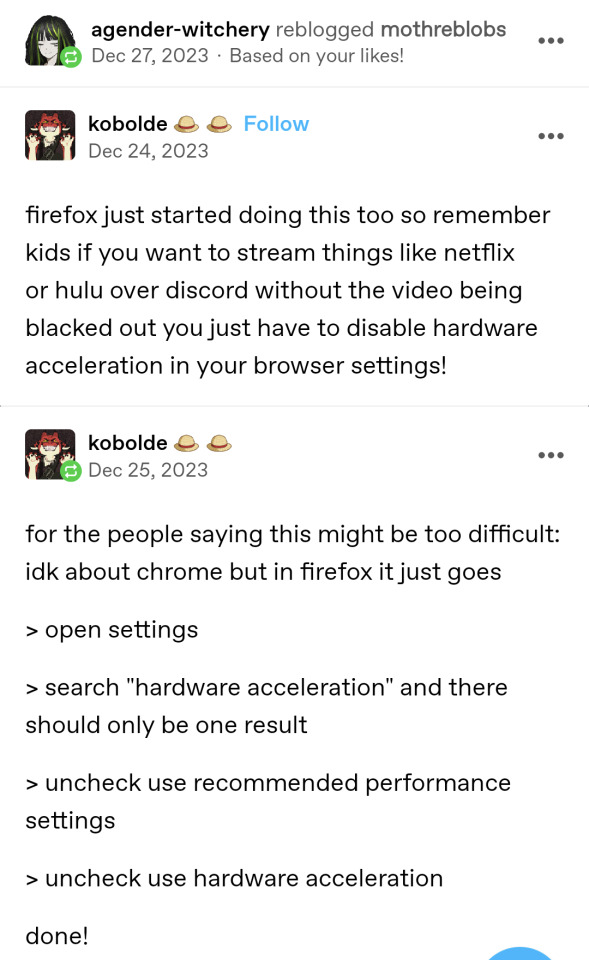
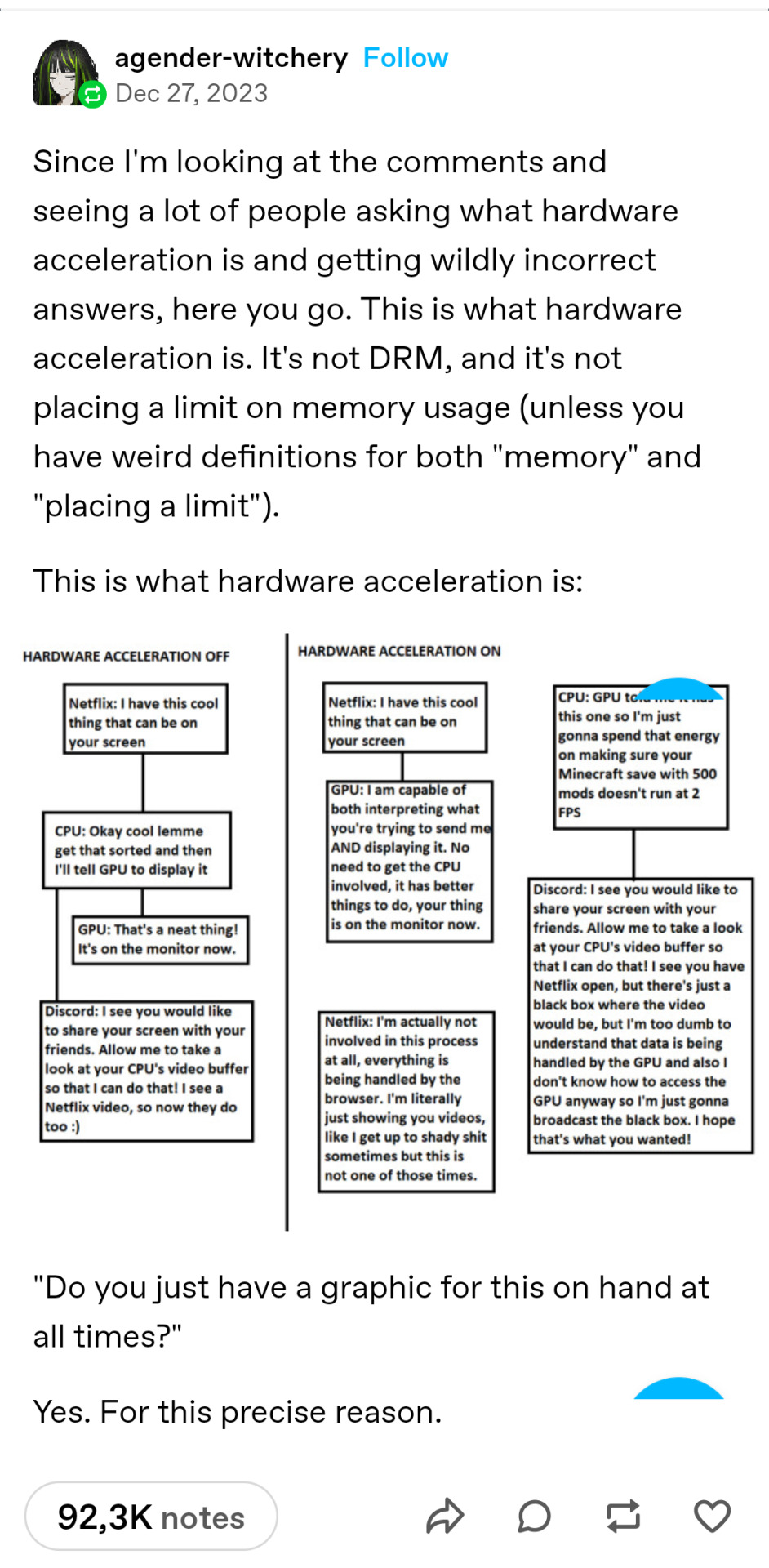
90k notes post completely misrepresenting why screenshotting or re-streaming Netflix doesn't work. It's not just the hardware acceleration, it's DRM. if you take this post at face value it would follow that you're unable to screenshot pretty much any video game bc your GPU is involved which is obviously fucking wrong.
in the case of Netflix & co without hardware acceleration the CPU has the job of decrypting the DRM'ed video stream which makes it a) screenshotable and b) will significantly reduce quality since decrypting 1080p upwards with a CPU is too resource-intensive. With hardware acceleration (and assuming that every piece of hardware in the chain supports HDCP) the stream will remain encrypted and is passed to the display this way and therefore your OS can't take a screenshot of the content. But once again this is only the case if there's even any DRM used. For example YouTube doesn't use HDCP (so you can take screenshots with hardware acceleration enabled) so the only thing you'd achieve when you disable hardware acceleration in this case is kneecapping your PC's performance. you're just making everything more inefficient, good job!
I mean, if your goal is capturing shit from Netflix then turning off hardware acceleration does work so regarding that the post is correct, but the explanation is shit and the implications of doing that are not explained at all (which is always fun if you offer solutions with unintended consequences to a non-tech-savvy audience).
#see this time i screenshotted the post instead of reblogging directly when calling someone a fucking idiot#I'm learning!
2 notes
·
View notes
Text
Your explanation for why disabling hardware acceleration bypasses it is correct, but this is very much caused by DRM—HDCP (High Definition Content Protection) specifically. Discord is perfectly capable of displaying content rendered by the GPU, because it can stream games (rendered by the GPU) and the rest of the browser window (also rendered by the GPU). And it can stream unprotected videos while hardware accelerated—it’s just protected content that doesn’t come through.
The reason you see black boxes with hardware acceleration on is because the browser is passing protected video straight through to the display, specifically intentionally encrypted to prevent streaming and screen recording from accessing it. The OS provides the APIs that Discord uses to stream the screen, via a service called the “compositor” which is what stitches different parts of the screen together into one image, and OSes with HDCP intentionally stream protected content as black boxes (and make it black boxes in screenshots, etc). Turning off hardware acceleration means the browser manages its own window compositing and that goes around HDCP. It also probably means you don’t get full resolution video on Netflix etc. but that’s fine, you get it good enough.
firefox just started doing this too so remember kids if you want to stream things like netflix or hulu over discord without the video being blacked out you just have to disable hardware acceleration in your browser settings!
158K notes
·
View notes
Text
2025 Is the Year to Invest in OTT APP Development with ideyaLabs

OTT streaming services dominate the market. Traditional broadcasting methods struggle to keep up. Businesses see the potential of OTT apps. They allow content delivery straight to the consumer. ideyaLabs stands at the forefront of OTT APP Development in 2025. Our expertise and technology enable your business to leverage the full capabilities of OTT apps.
Understanding the Importance of OTT App Development in Today's Market
OTT apps bypass traditional distribution channels. Viewers gain convenience and flexibility. OTT services enhance viewer engagement. ideyaLabs provides bespoke OTT APP Development. Our OTT services provide unparalleled user experience, stronger security features, and seamless performance.
Growth in OTT Content Consumption
2025 sees an unprecedented rise in OTT content consumption. The shift from traditional cable to OTT streaming represents a massive opportunity. ideyaLabs helps you harness that potential. OTT apps offer personalized content and recommendations. They increase viewer satisfaction. ideyaLabs equips your business with these features.
Key Components of Successful OTT APP Development
User experience ranks top among key components. ideyaLabs focuses on creating intuitive interfaces. Easy navigation and sleek design attract users. They enhance the viewing experience.
Content management and delivery are vital. ideyaLabs ensures smooth content uploading and management. We integrate various content formats. We offer live streaming, video-on-demand, and more. We use adaptive streaming techniques. Video quality adjusts to the viewer's internet speed. Buffering reduces.
Security measures cannot be overlooked. ideyaLabs implements secure payment gateways. DRM (Digital Rights Management) prevents unauthorized access. Sensitive data gets encrypted, ensuring privacy and security.
How ideyaLabs Utilizes Advanced Technology in OTT APP Development
Artificial Intelligence (AI) enhances user engagement. We implement AI algorithms to analyze viewer behavior. Personalized content recommendations result. They improve viewer retention rates.
Our apps integrate Augmented Reality (AR) and Virtual Reality (VR). Immersive experiences boost viewer interaction.
Machine Learning (ML) techniques predict viewership trends. This guides content strategy. You create the right content at the right time.
Scalability and Flexibility of OTT Apps Developed by ideyaLabs
Our OTT apps support scalability. Handle large user bases without compromising performance. Flexibility allows your app to adapt to various devices. Smart TVs, mobile phones, tablets, and desktops are included. ideyaLabs ensures your content is accessible anywhere, anytime.
Revenue Models for OTT Apps
Subscription-based models guarantee a steady income. Viewers pay a recurring fee for content access. ideyaLabs integrates secure and flexible subscription options.
Ad-supported models generate revenue through advertisements. Our apps ensure ad placements do not disrupt the viewing experience.
Pay-per-view models offer an alternative. Viewers pay for specific content. Live events or exclusive shows can use this model effectively.
Best Practices for OTT APP Development with ideyaLabs
We continuously test and improve app performance. Regular updates keep your app relevant. ideyaLabs incorporates user feedback. We focus on enhancing usability. We prioritize speed and reliability. Your viewers get a seamless experience.
Our team offers 24/7 support. Technical issues get resolved promptly. Your app runs smoothly. Viewer satisfaction remains high.
Market Trends and Future of OTT Streaming Services
The market trends indicate sustained growth. More people cut the cord. More subscribers join OTT platforms. ideyaLabs stays ahead of these trends. Our solutions evolve with the market. We implement cutting-edge technologies. Your business stays competitive.
Hybrid models gain popularity. They combine subscription and ad-supported models. ideyaLabs helps you adopt these strategies. Maximize your revenue streams.
Choosing ideyaLabs for Your OTT APP Development Needs
Our extensive experience sets us apart. We deliver customized solutions. Your app aligns with your brand identity. Ideal user experiences result. Your audience remains engaged.
Our development process is transparent. ideyaLabs emphasizes collaboration. We keep you involved at every stage. Launch your app on time and within budget.
Conclusion
OTT APP Development represents the future of content delivery. ideyaLabs stands ready to transform your vision into reality. Our innovative solutions meet modern demands. Join the revolution with ideyaLabs. Let us build your OTT app today. Your business will thrive in the dynamic world of OTT streaming services.
0 notes
Text
What is the Prediction of OTT App 2025? Investing in OTT App Development Profitable?
The Over-the-Top (OTT) industry has seen explosive growth in recent years, changing the way people consume content. With traditional cable TV declining and streaming services taking over, the future of OTT App Development looks more promising than ever.
By 2025, the OTT market is expected to surpass $400 billion, driven by advancements in AI, 5G, cloud computing, and personalized content delivery. But the real question is: Should you invest in OTT App Development?
This article explores the future of OTT apps in 2025, industry predictions, and whether launching an OTT platform is a profitable venture. We’ll also discuss how an OTT App Development Company can help you create a scalable and competitive streaming service.
1. The Future of OTT Apps: Market Predictions for 2025
Rapid Growth in OTT Consumption
By 2025, it is estimated that over 3 billion users worldwide will be streaming content via OTT platforms. This growth is fueled by: ✔️ 5G technology for ultra-fast streaming. ✔️ Smart TVs & Connected Devices boosting viewership. ✔️ Rise of niche OTT platforms for targeted audiences. ✔️ Subscription-based & Ad-supported models expanding revenue streams.
Global Market Expansion
North America & Europe: The biggest markets, driven by Netflix, Disney+, and Amazon Prime.
Asia-Pacific: The fastest-growing region, led by India, China, and Indonesia.
Middle East & Africa: Increasing demand for localized content and mobile streaming.
With OTT Development experiencing global expansion, businesses have a massive opportunity to tap into this growing industry.
2. Why Is Investing in OTT App Development Profitable?
1. Rising Demand for On-Demand Content
Consumers now prefer streaming over traditional cable TV. With smartphones, smart TVs, and tablets becoming primary entertainment sources, launching an OTT platform ensures a steady revenue stream.
2. Subscription-Based Revenue Model (SVOD)
Most OTT platforms generate revenue through monthly or annual subscriptions. Services like Netflix, Disney+, and HBO Max follow this model, generating billions annually.
3. Advertising-Based Model (AVOD)
Platforms like YouTube and Pluto TV thrive on ad-supported streaming, where brands pay for ad placements. This model allows free content access while generating revenue.
4. Pay-Per-View (TVOD)
Some platforms charge users per movie or event, a model used by Amazon Prime and sports streaming apps. Live concerts, sports events, and exclusive content drive this model’s success.
5. Hybrid Monetization Strategy
Many platforms combine SVOD, AVOD, and TVOD for multiple revenue streams, maximizing profitability.
Given these factors, investing in OTT Platform Development is a smart business move for content creators, media companies, and startups.
3. Key Features of a Successful OTT Platform in 2025
To build a successful streaming platform, you need robust OTT App Development Solutions. Here are the must-have features:
📲 Multi-Device Compatibility
Users should stream content across mobile devices, smart TVs, tablets, and web browsers for a seamless experience.
🎥 High-Quality Video Streaming
Adaptive Bitrate Streaming (ABR) ensures smooth playback, even in low-bandwidth areas.
🔍 AI-Based Content Recommendation
Machine Learning algorithms analyze user preferences to provide personalized content suggestions, improving engagement.
📅 Live Streaming Support
Essential for sports, concerts, news channels, and live events, increasing viewer retention.
🔐 Secure Payment & Subscription Management
Integration with payment gateways like Stripe, PayPal, Apple Pay, and Google Pay ensures hassle-free transactions.
🛡️ Advanced Security Features
End-to-end encryption, Digital Rights Management (DRM), and multi-factor authentication prevent piracy.
🗣️ Multi-Language Support & Subtitles
Expanding global reach with localized content, subtitles, and dubbing options.
A professional OTT Application Development Company can integrate these features to create a powerful and engaging platform.
4. Choosing the Right OTT App Development Company
Developing an OTT app requires expertise in UI/UX, video streaming technologies, security, and cloud-based infrastructure.
How to Select an OTT Platform Development Company?
✔️ Experience in OTT App Development Services with a strong portfolio. ✔️ Expertise in building scalable and cloud-based streaming platforms. ✔️ Support for cross-platform development (Android, iOS, Smart TVs, Web). ✔️ Strong security and DRM protection against piracy. ✔️ Post-launch maintenance & technical support.
A top OTT App Developers team ensures that your platform meets industry standards and delivers an exceptional user experience.
5. Cost of OTT App Development
The cost of Custom OTT App Development depends on various factors:
Platform Type: Mobile, Web, Smart TV.
Technology Stack: AI, Cloud Streaming, CDN Integration.
Features & Customization.
UI/UX Complexity.
Security & Compliance Needs.
Estimated Development Costs
OTT Platform Feature
Estimated Cost (USD)
Basic OTT App (Web & Mobile)
$20,000 - $50,000
Advanced OTT App (AI, Multi-Device Support)
$50,000 - $150,000
Live Streaming & Cloud Integration
$70,000 - $200,000
Security & DRM Protection
$20,000 - $50,000
Maintenance & Updates
Variable
Working with a leading OTT Platform Development Company ensures you get a high-quality, scalable, and secure streaming app.
6. Future Trends in OTT Development by 2025
To stay ahead in the OTT industry, businesses must adopt emerging trends.
🔹 AI-Powered Personalization
Machine Learning will improve content recommendations and user engagement.
🔹 5G-Driven Streaming Revolution
Faster streaming speeds will enhance buffer-free 4K and 8K streaming experiences.
🔹 Blockchain for Secure Transactions
OTT platforms will use blockchain to prevent fraud and piracy while offering secure subscription payments.
🔹 Interactive & Immersive Content (VR & AR)
Virtual Reality (VR) and Augmented Reality (AR) will provide interactive viewing experiences for concerts, sports, and movies.
🔹 Cloud-Based Video Streaming
Cloud integration will reduce infrastructure costs and ensure seamless scalability.
Investing in OTT App Development Solutions with these futuristic features will give your platform a competitive edge.
7. Challenges in OTT Platform Development & How to Overcome Them
Despite its potential, OTT App Development comes with challenges:
1. Content Licensing & Copyright Issues
Solution: Work with legal experts to acquire proper licenses.
2. Monetization & Revenue Generation
Solution: Use a hybrid model (subscription, ads, pay-per-view) for diversified revenue streams.
3. Competition from Global Giants
Solution: Focus on niche markets, regional content, and unique user experiences.
4. High Infrastructure Costs
Solution: Use cloud-based solutions to optimize storage and reduce expenses.
By partnering with an experienced OTT App Development Company, you can navigate these challenges effectively.
8. Conclusion: Is Investing in OTT App Development Worth It?
✅ YES! Investing in OTT App Development is highly profitable.
The OTT industry is growing exponentially, with billions of users worldwide.
Multiple revenue models (subscription, ads, pay-per-view) ensure sustainable earnings.
Emerging technologies (AI, 5G, blockchain, VR/AR) are transforming user experiences.
Cloud-based and cross-platform compatibility make it easier to scale and expand.
If you’re considering launching an OTT platform, now is the perfect time to invest in OTT Development. With the help of a top OTT Platform Development Company, you can build a feature-rich, secure, and scalable streaming service that thrives in the future of entertainment.
🚀 Ready to build your OTT app? Get started today with expert OTT developers!
#custom ott app development#ott app development#ott app development company#ott app development services
0 notes
Text
DRM Video Encryption Software or DRM Player to protect your video content
DRM video encryption software - Digital Rights Management (DRM) is a process that secures digital content such as video to prevent unauthorized use and piracy of copyrighted material. Accessing the content requires authentication of both the user and the period of time requested.
Our iShieldProtect® content security solutions provide security to your digital content to avoid piracy and illegal usage.
iShieldProtect® offers 128-bit DRM video encryption software with DRM Player which protects your videos and content from unauthorized access.
Dissuading from Camera recording - Dynamic watermarks are displayed at different parts of video at random intervals with different information like Name, User ID, IP Address to dissuade students from camera capture.
Tamper proof license Based Security - License key will work only on a single machine identified on the basis of multiple parameters to ensure its uniqueness so that same license can never ever be used on 2 machines installed using cloning software.
Start your free trial now 9164006065
#DRM Video Encryption Software#DRM player#drm video protection software#drm player#drm protection software#drm video encryption#drm software for video#drmprotected video testing#drm protected video testing
0 notes
Text
Why is it critical to safeguard your video material with DRM technology?
DRM-protected video content is critical for reducing unlawful access, piracy, and distribution, as well as preserving intellectual rights and revenue streams.
0 notes
Text
Mastering Streaming Video Hosting for Beginners

Streaming Video Hosting has become a staple of media consumption, with platforms like YouTube, Netflix, and Twitch pushing the boundaries of how and where we watch videos. However, creating a smooth streaming experience requires meticulous attention to various technical and strategic factors. For content creators and streaming services, optimizing video content is crucial for reducing buffering, improving quality, and ensuring user satisfaction. This article explores the key strategies and technologies involved in optimizing video content for seamless streaming.
Understanding the Basics of Streaming Video Hosting
Streaming Video Hosting is the process of transmitting video files from a server to a user's device in real time. The user’s device decodes the data stream and plays the video without fully downloading it. To achieve seamless streaming, videos must be optimized in several ways, starting with compression and formatting.
Video Compression and Codecs
Video compression is essential to reduce the file size without significantly compromising video quality. Effective compression techniques make videos easier to transmit over various internet speeds. Codecs, which stand for "compressor-decompressor", are used to encode and decode digital video. Popular codecs include H.264, HEVC (H.265), and VP9. Each codec varies in terms of compression efficiency and compatibility with devices and browsers.
Adaptive Bitrate Streaming (ABS)
Adaptive Bitrate Streaming is a technique used to adjust the video quality in real time based on the viewer’s available bandwidth. ABS enhances the viewing experience by minimizing buffering and avoiding the degradation of video quality. Major streaming platforms utilize ABS to dynamically serve the best possible video quality at any given time.
Content Delivery Networks (CDNs)
Content Delivery Networks are another crucial element in optimizing video streaming. CDNs distribute the video content across various servers located in different geographical locations. When a user requests a video, it is served from the nearest server, which reduces latency, decreases buffering times, and improves load speeds.
Best Practices for Video Optimization
Beyond technical adjustments, several best practices can enhance the streaming video hosting experience:
Choose the Right Hosting Solution: Whether it’s a dedicated server, cloud hosting, or a CDN, selecting the right hosting solution based on the audience size and geographical spread is vital.
Opt for Multi-Bitrate Encoding: Offering multiple bitrate options allows the streaming video hosting service to adjust to different internet speeds and device capabilities.
Thoroughly Test Video Quality: Regular testing across different devices and network conditions is essential to ensure consistent video quality and functionality.
Monitor Analytics: Utilize analytics to understand viewer behavior, device usage, and network conditions to continuously refine streaming video hosting strategies.
Optimizing Mobile Streaming
With increasing mobile device usage, optimizing videos for mobile streaming video hosting is crucial. This includes ensuring that videos are encoded in mobile-friendly formats, using responsive design principles, and implementing touch-friendly player controls. Furthermore, considering the use of lighter mobile-specific codecs like VP9 can help in faster loading times and lower data consumption.
Enhancing User Experience (UX)
To ensure a seamless streaming video hosting experience, UX designers and developers should focus on creating an intuitive and engaging interface. Elements such as easy navigation, quick access to video controls, and minimal buffering contribute significantly to user satisfaction. Additionally, including features like video previews, quality selectors, and seamless transitions from one video to another can greatly enhance the viewing experience.
Facing Challenges in Streaming Video Hosting
Content creators and streaming video hosting services often face several challenges such as high bandwidth costs, varied internet speeds among users, and the need for massive scalability during peak times. To address these issues, implementing advanced compression technologies, using efficient transmission protocols, and scaling infrastructure dynamically are vital strategies.
Future Trends in Video Streaming
Looking ahead, emerging technologies such as AI-driven compression, edge computing, and 5G are set to revolutionize the streaming video hosting industry. AI can optimize encoding settings in real time for optimal quality and minimal bandwidth usage. Edge computing will help in processing data closer to the end user, reducing latency significantly. Additionally, the rollout of 5G technology promises substantially higher speeds and more reliable connections, which will further enhance streaming video hosting capabilities.
In conclusion, optimizing video content for seamless streaming video hosting involves a well-rounded approach that includes technical optimizations, strategic planning, and continual adaptation to emerging trends and technologies. By focusing on these aspects, content creators and streaming video hosting platforms can ensure high-quality, buffer-free experiences that meet the evolving demands of modern viewers. please don’t hesitate to contact us via email or phone for further assistance!
#streaming video hosting#cloud video platform#secure video hosting#drm encrypted video streaming#security video#drm software#online video platform
0 notes
Text
From Idea to Launch: How to Build and Scale Your Video Streaming Website
Introduction
The rise of platforms like Netflix, YouTube, and Twitch has fueled the demand for video streaming websites. If you want to create your own, this guide will walk you through the process from start to finish.
Why Build a Video Streaming Website?
A video streaming platform can generate revenue through advertisements, subscriptions, and pay-per-view models. It also provides an opportunity to engage audiences with unique content.
Types of Video Streaming Platforms
Live Streaming
This type includes real-time broadcasting, like Twitch and Facebook Live.
On-Demand Streaming
Platforms like Netflix allow users to watch content at their convenience.
Hybrid Platforms
A mix of live and on-demand streaming, often seen in sports and educational platforms.
Key Features of a Video Streaming Website
High-quality video playback
User authentication and profiles
Subscription and payment integration
Search and categorization
Secure video hosting
Planning Your Video Streaming Website
Before development, define your niche, target audience, and revenue model.
Choosing the Right Tech Stack
Frontend Development
HTML, CSS, JavaScript (React, Angular, Vue.js)
Backend Development
Node.js, Python, Ruby on Rails
Database Management
MySQL, MongoDB
Content Delivery Network (CDN)
Cloudflare, AWS CloudFront
Getting the Right Hosting Solution
Select a scalable cloud hosting service like AWS, Google Cloud, or DigitalOcean.
Designing an Intuitive User Interface (UI) and User Experience (UX)
Make navigation simple and optimize for mobile-friendliness.
Developing the Video Streaming Website
Backend Development
Build the server and database infrastructure.
Frontend Development
Create a user-friendly interface.
Integrating Video Hosting
Use services like AWS Media Services or Vimeo OTT.
Monetization Strategies for Your Streaming Website
Subscription-Based Model (Netflix-style)
Advertisement-Based Model (YouTube-style)
Pay-Per-View Model (Event-based streaming)
Security Measures for Video Streaming Platforms
SSL encryption
Digital Rights Management (DRM)
Secure payment gateways
Testing and Launching the Platform
Conduct performance, security, and usability testing before launching.
Marketing and Growing Your Video Streaming Website
SEO optimization
Social media marketing
Influencer partnerships
Future Trends in Video Streaming
AI-powered content recommendations
360-degree and VR streaming
Blockchain-based security solutions
Conclusion
Building a video streaming website requires strategic planning, a solid tech stack, and a user-centric approach. With the right execution, you can create a successful platform that stands out in the competitive market.
FAQs
1. How much does it cost to build a video streaming website?
The cost varies based on features, development team, and hosting, ranging from $10,000 to $100,000.
2. Do I need a content delivery network (CDN)?
Yes, a CDN improves loading speed and ensures smooth video playback.
3. Can I build a video streaming website without coding?
Yes, platforms like Uscreen and Vimeo OTT offer no-code solutions.
4. How do I secure my video content from piracy?
Use Digital Rights Management (DRM) and watermarking techniques.
0 notes
Text
Seamless Streaming Experience: How Media Jungle Optimizes Video Playback Across Devices
In the competitive world of OTT streaming, user experience is everything. A seamless playback experience—without buffering, lag, or quality drops—is what keeps viewers engaged and satisfied. Media Jungle ensures smooth, high-quality streaming across multiple devices by integrating cutting-edge technology. Here’s how:
1. Adaptive Bitrate Streaming (ABR) for Buffer-Free Playback
Not all users have the same internet speed. Media Jungle’s Adaptive Bitrate Streaming (ABR) automatically adjusts video quality based on the viewer’s bandwidth and device capabilities. 🎯 How it works: ✅ Detects the user’s internet speed in real time. ✅ Adjusts video resolution dynamically (e.g., 1080p → 720p → 480p) to prevent buffering. ✅ Ensures continuous, smooth playback—even on fluctuating networks.
🎥 Result: Viewers get the best possible quality without interruptions, even on slow connections.
2. CDN Integration for Lightning-Fast Streaming
A Content Delivery Network (CDN) is a global network of servers that helps distribute content efficiently. Media Jungle integrates with top-tier CDNs to: ⚡ Reduce latency – Content loads faster as it's delivered from the nearest server. 🌍 Improve global reach – Users experience seamless streaming, no matter their location. 📉 Minimize buffering – Even during peak hours, CDN caching ensures smooth playback.
🎥 Result: Faster load times, reduced lag, and a consistent streaming experience worldwide.
3. Multi-Device Compatibility: Watch Anytime, Anywhere
Viewers today switch between devices—smartphones, tablets, smart TVs, and desktops. Media Jungle ensures full compatibility across: 📱 Mobile Apps (iOS & Android) – Optimized for smooth playback on smaller screens. 💻 Web Browsers (Chrome, Safari, Firefox, Edge) – Instant access without downloads. 📺 Smart TVs & Streaming Devices – Supports Firestick, Roku, and Android TV.
🎥 Result: Users can start watching on one device and seamlessly continue on another.
4. Cloud-Based Encoding for Faster Content Delivery
To maintain high-quality streaming without long processing times, Media Jungle uses cloud-based video encoding. 🎬 Benefits: ✅ Optimized for multiple resolutions – Streams in 4K, 1080p, 720p, and lower resolutions. ✅ Efficient compression – Reduces file sizes without compromising quality. ✅ Quick content delivery – New uploads are processed and streamed instantly.
🎥 Result: Viewers get crystal-clear visuals with minimal buffering.
5. Low Latency Streaming for Real-Time Engagement
For live sports, events, or interactive streaming, low latency is crucial. Media Jungle’s advanced streaming infrastructure ensures: 📡 Real-time content delivery – Minimal delay between the live event and the viewer. 📊 Smoother interactions – Ideal for live Q&A, auctions, and gaming streams. 🎮 Sync across devices – Ensures all users experience the same moment simultaneously.
🎥 Result: Viewers stay engaged with ultra-low latency streaming, even in live broadcasts.
6. AI-Powered Video Compression for Efficient Streaming
Media Jungle uses AI-driven compression algorithms to deliver high-quality videos without excessive data usage. 🚀 How it works: ✅ Reduces bandwidth consumption – Streams high-quality video with lower data usage. ✅ Preserves visual details – AI ensures clarity in every frame. ✅ Enhances mobile streaming – Saves data while maintaining smooth playback.
🎥 Result: Faster load times, better mobile viewing, and cost savings for both users and businesses.
7. DRM & Secure Playback to Protect Content
Security is just as important as performance. Media Jungle’s DRM (Digital Rights Management) ensures: 🔒 No unauthorized downloads or piracy. 🔒 Geo-blocking to control content access in specific regions. 🔒 Secure encryption to protect premium content.
🎥 Result: Your content stays protected while delivering a premium viewing experience.
Elevate Your Streaming Experience with Media Jungle
A flawless streaming experience is essential to keeping viewers engaged. Media Jungle ensures: ✅ Buffer-free, adaptive streaming for all internet speeds. ✅ Global CDN delivery for lightning-fast playback. ✅ Seamless compatibility across mobile, web, and smart TV. ✅ Low-latency streaming for live events and real-time interactions. ✅ Secure DRM protection to safeguard content.
🚀 Want to provide the ultimate viewing experience? 👉 Get started with Media Jungle today! 🎬
0 notes